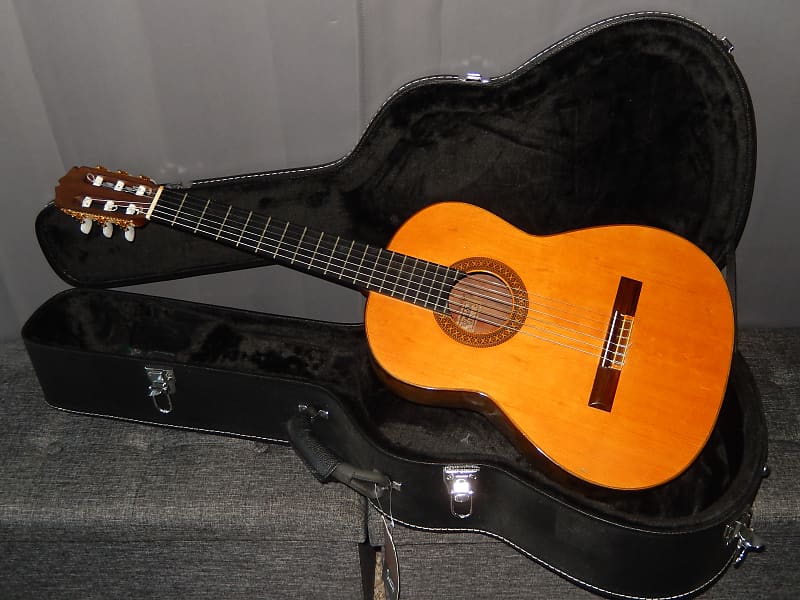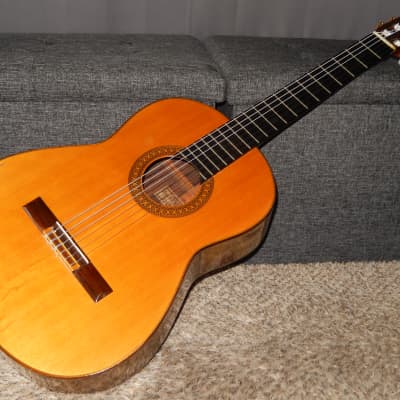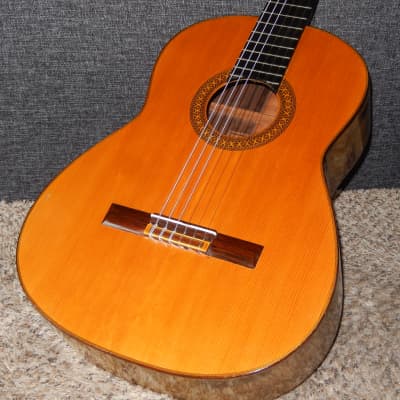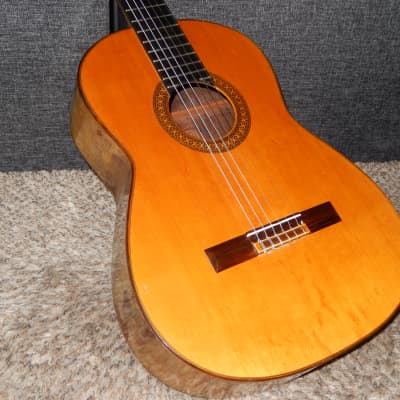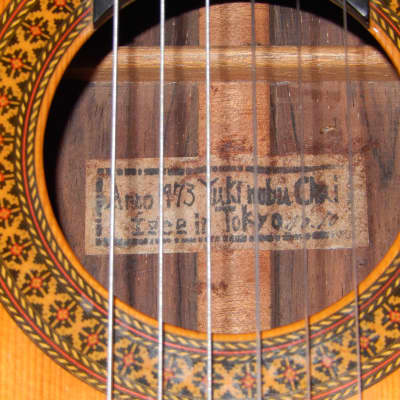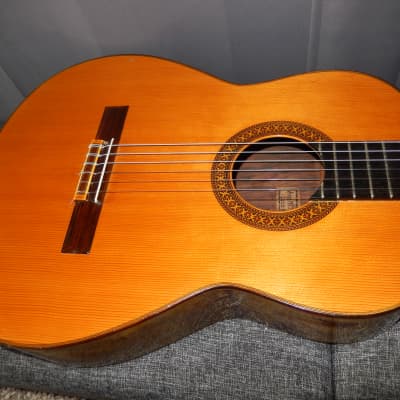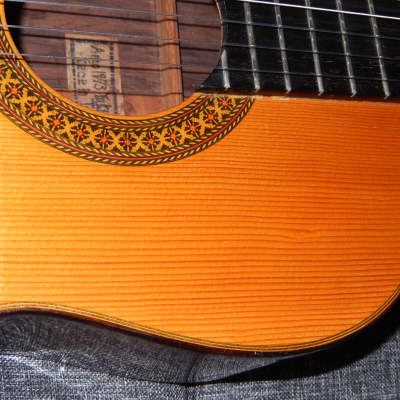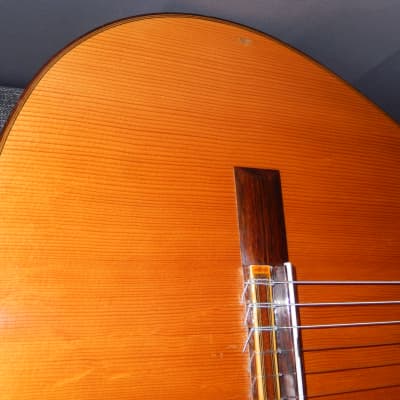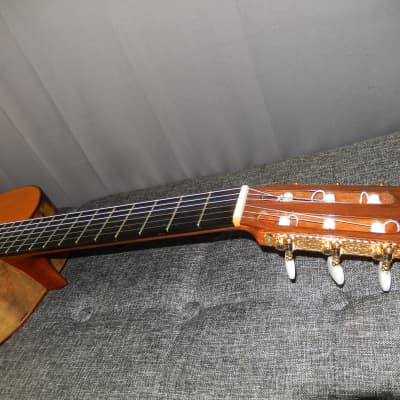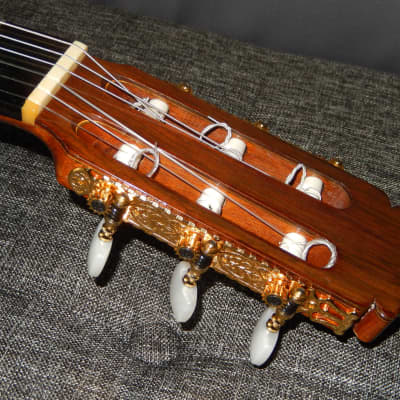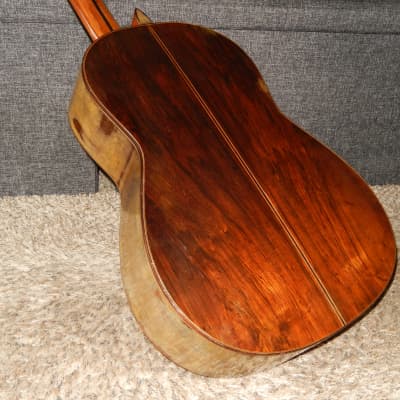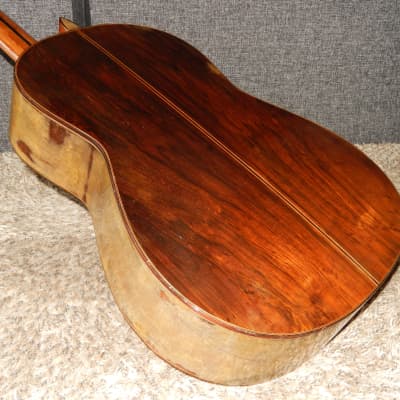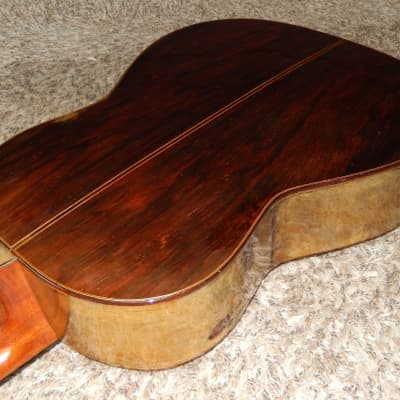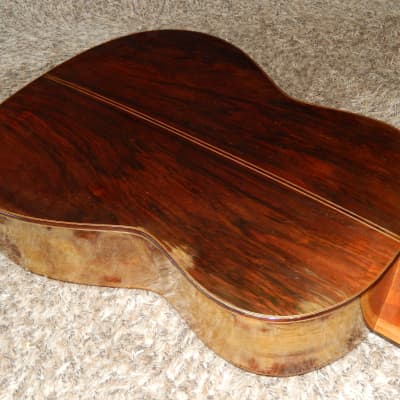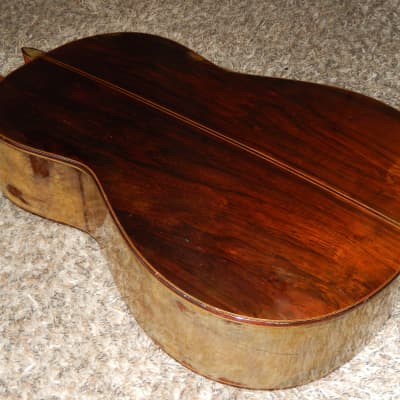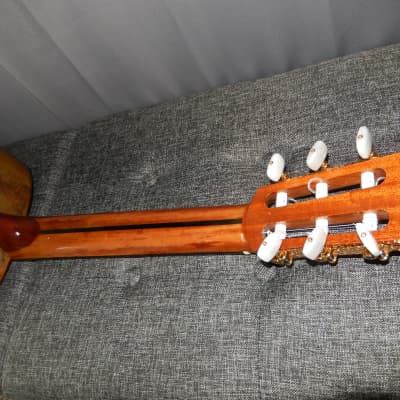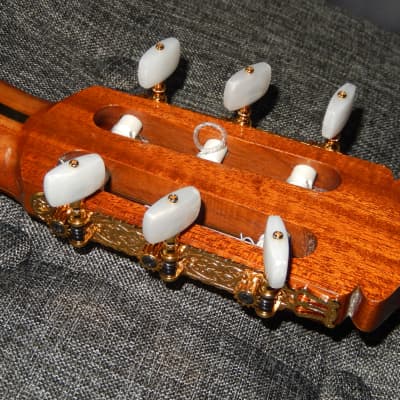Several hundred guitars I have sold in the past are presented at Facebook.com/Victors.Guitar.Library.
Yukinobu Chai Classical Concert Guitar No10 1973
This guitar was made in 1973 by Master Luthier Yukinobu Chai. It was his top-of-the-line model of that year. It represents the highest level among Japanese made classical guitars of any era.
Yukinobu’s career started in late 1960s and over the years he became one of the highest respected luthiers in Japan. One of the major reasons for that were very moderate prices for his wonderful instruments.
In that respect Yukinobu had business philosophy very similar to that represented by Ryoji Matsuoka, Kazuo Yairi or Hiroshi and Mitsuru Tamura. Yet in early 1970s his prices were still lower than prices proposed by listed above guitar makers and way lower than prices charged by top elite Japanese luthiers like Masaru Kohno and Sakazo Nakade.
In 1974 top of the line Masaru Kohno’s model 30 and Sakazo Nakade’s Master 30 were priced 300 000 yen. Few other well established Japanese makers had 200 000 yen models (Yamaha GC20D, Mitsuru Tamura 2000, Masaji Nobe 20 or Teruaki Nakade C20). For several other makers 150 000 yen was the maximum they could charge for their top models (Toshihiko Nakade 1500, Hiroshi Tamura P150, Ryoji Matsuoka 150 or Kazuo Yairi Y150). For many other (less prominent) makers 100 000 yen was that maximum price.
Yet within just few years Yukinobu has earned enough respect among guitar enthusiasts to be able to catch up with the competition regarding pricing of his instruments. By 1975 his top model (20) was priced 200 000 yen and by 1977 his top model (30) was priced 300 00 yen, and in 1980 he had his own 500 000 yen model (50).
Because in early 1970s Japan experienced a quite rapid inflation (it reached 25% in 1974), all guitar makers were frequently raising prices for their top models. In 1977 Masaru Kohno’s top model 50 was priced 500 000 yen, while it was no different from his model 30 made in 1973.
As of today, top of the line models made by Japanese elite makers are priced at $10000USD level. However, custom made models with old Brazilian Rio Rosewood b/s are being priced $15000USD (like Yamaha GC70).
I hope that all this information will help you recognize the true value of instrument you are looking at.
In early 1980s Yukinobu became the major supplier for Niibori School of Guitar Ensemble, making not only whole range of prime (regular) models but also many alto, soprano, bass and contrabass guitars. Since Yukinobu's passing in 2011, his workshop has been managed by his son Yukihiro, a great luthier on his own. Yukinobu's most famous pupils are Ichizo Kobayashi, Tatsuro Kobayashi, Sakae Ishi and Kuniyoshi Matsui.
Introduction from Chai Guitar Craft Facebook page:
Thank you for visiting our WEB site.
My father, Yukinobu Chai, started the guitar crafting about 55 years ago at Tamagawa Gakuen, Tokyo Japan. He was interested in making the violin when he was a student. Since then, he added many strings instruments. In 1960's, it was very popular for Japanese to play the classic guitar. This was influenced by famous movie "Jeux interdits"
My father never get a lesson from other violin builder. He just learned all from book and real violins. For Guitars, Of course, he never made it before. He has transferred some constructions from Piano. It made Chai Guitar sound & tone. He was always trying to reach his aimed tone "Sound that spread richly".
I always look at his works beside him. Naturally I started to help him. Well, it was about 20 years ago. He passed away several years ago. Now, I'm doing his work and trying to establish the Chai Guitar Brand worldwide.
Chai Guitar Craft
Yukihiro Chai President
To my ears, Yukinobu Chai was one of the best Japanese luthiers ever and remains my favorite Japanese luthier since I encountered his guitars made in 1970s. I am totally not bothered by discolorations of finishes on his guitars from that era. After selling several of his guitars I know that truly experienced guitarists looking for a “truly special” instrument are not bothered by these cosmetic imperfections either. I deeply understand why Hiroki Niibori has decided to offer Yukinobu such lucrative contract.
This guitar offers very high volume and super response, combined with uniquely magical tonality: relatively deep punchy somewhat metallic (cello like) basses, very strong round but ultra-clear ringing trebles (one could describe as resembling midsize crystal bells), all well balanced, with superb note clarity and separation and very impressive sustain.
Overall condition of this guitar can be described as "very good for its age". While it is structurally sound and is very playable, it comes with several imperfections.
Its top bears several small scratches, one small but deep dent and about 2 inch long (repaired) crack. Its back and sides bear several light scratches and rubbing marks. Several light dents/attritions are visible along its bindings. There are few light dents of the tip of the headstock. There are at least few other minor cosmetic imperfections one can find on the body of this guitar.
Sections of original finish at the seam between E1 side of the fingerboard and the soundboard, has dried and later exfoliated. Yet it is not associated with any crack or gap in that area.
Perhaps the most noticeable “imperfection” is that its sides are “cloudy”. Such cloudiness occurs only within the finish while the wood itself doesn’t lose its natural color. It is often a result of mixing finishes, like covering shellac with cashew lacquer. After cashew lacquer dries it is harder, more durable and scratch resistant than shellac. Later as the shellac ages it becomes “cloudy”. Intensity of this cloudiness also depends on what shellac formula was used. Sometimes instead of uniform cloudiness, there are only a few “fingerprints” visible. These “fingerprints” are traces of shellac pads. Such finish cloudiness is most pronounced on Brazilian Rosewood.
The fingerboard show some wear, especially on the treble side with deepest grooves located between 2nd and 3rd fret. The frets however are not visibly worn. Quite likely, this guitar has been re-fretted sometime in the past yet without sanding the surface of the ebony fingerboard. Only another re-fret would allow the repair technician to re-level (smooth out) the surface of the fingerboard. Yet this is not necessary to be done any time soon. Guitar can be played “as it is” for several more years.
Very likely, soon after you start enjoying the gorgeous sound if this guitar, you will understand why someone else played it so intensively. You will also realize that this guitar is worth any kind of repair. You will not be bothered by the cloudiness of it finishes either.
Defective original tuners were replaced with brand new high grade Gotoh set.
"French polishing" is the application of shellac with the use of shellac pads. Shellac finish on guitars is always applied by “French Polishing”. On other wooden items and furniture shellac is usually applied by paint brush.
The great majority of Japanese luthiers while finishing their high-end models, were using very thin coat of cashew lacquer as the last layer over the shellac usually only on the back and sides. Some luthiers (like Masaru Kohno, Ryoji Matsuoka, Hiroshi Tamura) were using this approach also on the soundboards. Cashew lacquer is more durable and resistant to wear and scratches etc. and that is why Japanese were using this method. Therefore, when there is Cashew lacquer on the surface, it is very likely there is a shellac underneath.
ALL YUKINOBU CHAI GUITARS MADE IN 1970s OFFER FEW HUGE ADVATAGES OVER GREAT MAJORITY OF VINTAGE CLASSICAL GUITARS: THEIR NECKS ARE SLIMMER THAN NECKS OF MOST VINTAGE GUITARS, THEIR ACTION CAN BE SET VERY LOW (IF DESIRED), THEIR GREAT RASPY RESPONSE TO RASQUEADOS AND BRILIANTLY CRISPY RESPONSE TO PICADOS MAKES THEM EXCEPTIONALY GREAT CHOICE FOR FLAMENCO PLAYERS.
Specifications:
Top: High Grade Solid (Bear Claw) Yezo Spruce/Shellac
Back & Sides: Highest Grade Solid Figured Brazilian Rosewood/Cashew lacquer
Neck: Mahogany with Ebony insert
Fingerboard: Ebony
Scale: 650 mm
Nut width: 51 mm
Its current action is set to 3.00 mm under E6 and 2.50 mm under E1, just because it was possible. Its original saddle sets this action at (standard for classical guitars) 4.5mm E6 and 4.00mm E1. You can use either saddle or set this action “your way”.
This guitar will be shipped in brand new hard shell case.
When contemporary Japanese luthiers are using 40+ years old soundboards to make “all solid woods” guitar it is priced at least $5000USD. Guitars with artificially aged (“baked”) soundboards are priced at least $4500USD. Solid top models with 40+ years old soundboards are priced at least $3500USD. American, Australian and European luthiers usually charge 50% more.
It is a matter of basic education (not beliefs) to realize that 50+ years old soundboard of this guitar alone is worth $2500USD.
Real Value of Japanese Vintage Guitars
The key to understand value of vintage Japanese guitars is to acknowledge galloping price inflation (devaluation of Japanese yen) during 1960s & 1970s. This inflation slowed down in 1980s.
During 1960s and most of 1970s model numbers of Japanese guitars were strictly interconnected with their prices in Japanese yen. By early 1980s and during following decades model numbers were no longer strictly associated with their prices. Some Japanese guitar makers introduced model names instead of model numbers. Others were still using model numbers with addition of letters and/or other symbols.
It is then important to understand that two Yamaha GC10 guitars made 10 years apart are two instruments of totally different class. The same applies to any other Japanese maker/brand.
The logical way to estimate the true class of any given Japanese made instrument is to compare its price with the average annual salary of wage workers in Japanese private sectors. This salary was: 450 600 yen in 1965 - 825 900 yen in 1970 - 1 868 300 yen in 1975 - 2 689 000 yen in 1980 - 3 163 000 yen in 1985 - 3 761 000 yen in 1990 - 4 107 000 yen in 1995 - 4 082 000 yen in 2000.
Any guitar priced 100 000 yen in 1970 (labelled as No10 or No100) would be priced 200 000 yen in 1975 (relabeled to No20, No200 or 2000), 300 000 yen in 1977 (labelled as No3, No30 or 3000) and 500 000 yen by 1985 (labelled as No50 or 5000).
Starting in 1977 Masaru Kohno introduced his new models No40 priced 400 000 yen and No50 priced 500 000 yen. By early 1980s Kohno started using model names instead of numbers and was steadily raising their prices without changing model labeling. His very top model 50 became model “Special”, and a decade later it became model “Maestro”. Naturally, all other Japanese guitar makers were doing similar pricing (labelling) upgrades.
Knowing all of that, you can bet on that Masaru Kohno No50 made in 1982 is practically the same grade instrument as Kohno No20 made in 1972, or Kohno no 30 made in 1975.
In early 1970s the lowest Ryoji Matsuoka (all plywood) model was 10, followed by (solid top) models 15, 20, 25, 30, 40, 50, 60, 80 and (all solid woods) models 100 and 150. Models 50, 60 and 80 were made with non-solid figured Brazilian Rosewood (double) back and sides and top model 150 was the only one made with solid figured Brazilian Rosewood b/s.
In 1980 the lowest Matsuoka model was (all plywood) 20, followed by (solid top) models 30,40,50, 60 and all solid woods models 80,100,150 and 200. By 1990 the lowest Matsuoka model was M40 and the highest was M300. By 2010 the lowest Matsuoka model was M50 and the top model was M270.
You can bet that Ryoji Matsuoka model 50 from 1980 is of the same grade as model M100 from 2000, model 100 from 1980 is of the same grade as model M150 from 2000, model 150 from 1980 is of the same grade as M200 from 2000 and model 200 from 1980 is of the same grade as model M300 from 2000.
It is important to mention that if modern era luthiers are using 40+ years old woods to make an “all solid” wood classical guitar, its price is minimum $8000.
All vintage guitars made with Brazilian Rosewood are especially precious, including those made straight grain varieties and those with non-solid b/s.
Because response and tonal properties of Spruce soundboards are improving over time, long seasoned Spruces are far more precious than long seasoned Cedars.
It is not very difficult to find out what are current prices of such guitars made by world’s leading luthiers.
